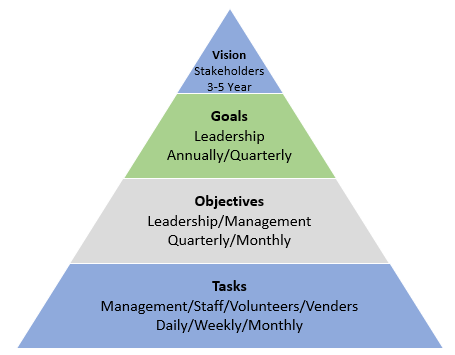
Most associations view strategic planning as a necessary evil and cringe when the three years are up and it’s time to do another plan. Over time Boards can become jaded and skeptical of the strategic planning process, “We waste time and money on developing a plan and it never goes anywhere”. If this sounds familiar, your association is starting with an ineffective plan and/or flawed process to implement. This 3-part series will help you renovate your strategic plan so volunteers can once again get excited about the process and see actual results.
Renovating your plan or developing a new one begins with an understanding of the basic strategic planning terms and how to utilize them. Most associations understand these terms but follow a defined path and thus end up with a plan that resembles every other association. I’ll provide examples of each to help understand the difference (fixer upper versus renovated). How do you make your plan unique, read on.
A mission statement is a written description of why association exists, the unique market niche it serves, and the core values it embraces. Mission is relatively fixed and unchanging. It changes only after careful consideration of the internal/external factors impacting the organization.
Easy to understand right? So how can you get this wrong. The key distinction here is to identify why your association exists versus the purpose of all associations. What makes your purpose unique? This is where most associations fall short. Here is an example:
- Fixer-upper: Our mission is to bring together a community of professionals.
- Renovated: The American Cancer Society’s mission is to save lives, celebrate lives, and lead the fight for a world without cancer
See the difference?
A vision statement is a statement about what association wants to achieve five years into the future. It should resonate with all members and help them feel proud, excited, and part of something much bigger than themselves. Vision should stretch its capabilities and self-image. It gives meaning, shape and direction to the organization’s goals, objectives and tasks.
Let’s exceed 5,000 members in five years, let’s double our income! Those are fine goals, but are they really going to get the association excited and feel part of something bigger? Like your mission, the vision needs to be unique to your association and specific to the field you serve. What do you really want to accomplish?
- Fixer-upper: To be the premier association blah blah blah
- Renovated: Habitat for Humanity: A world where everyone has a decent place to live
Every association wants to be “premier” or grow, what really motivates the Board? I hope you are seeing a trend by now.
The final set of terms crucial to every strategic plan, and typically make up the bulk of the plan are the goals, objectives, and tasks. Goals are the long term aims or targets essential to the achievement of the vision. If your vision is appropriately constructed, your goals will be targeted on ways to achieve it. Re-read the fixer upper vision, how could you develop goals to be “premier”? Or if your vision is to exceed a certain membership metric? Your Board will fall back on ways to improve operations or discuss marketing ideas. Defining the goals (three to five) are the most important step as it will dictate the focus of the association over the next few years. If you are starting with a poor vision, the plan is bound to not meet expectations. Objectives are the intermediate targets necessary to the achievement of intended goals and tasks are short term actions that result in the achievement of objectives, goals, and vision. All of these must be achieved in a manner aligned with your mission.
- Fixer-upper: Goal: Increase membership; Objective: Build a new website to attract more members.
- Renovated: Goal: Develop training for entry level professionals; Objective: Implement certificate program
If you are a visual learner like me, it helps to see how these terms interact with each other. As you see it all starts with the vision and works “down” from there.

Understanding the true purpose of these terms is the first step to renovating your strategic plan, but how do you lead your Board through this process and ensure the plan is accomplished? Part two of the series will cover tips to develop your plan virtually and part three on ways to help implement your plan. I hope you’ll continue with our renovation series!
Want to reach out to the author? Contact Pete Pomilio at [email protected].


